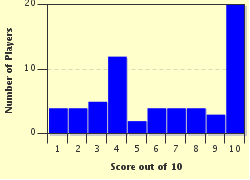Quiz Answer Key and Fun Facts
1. In 108 BC, Emperor Wu of the Han dynasty incorporated much of the Korean peninsula into the Chinese empire. What was the main administrative center that the Chinese established in Korea?
2. Which of Korea's "Three Kingdoms" survived the Chinese invasions of the seventh century AD?
3. Where was the medieval state of Parhae (or Balhae) located?
4. Which of these cities was the capital of the Koryo dynasty?
5. Who was the founder of Korea's last royal dynasty?
6. What was the greatest contribution to Korean culture made by King Sejong?
7. What secret weapon did the Korean Admiral Yi Sun-sin use to inflict repeated defeats on Japanese invaders in the 1590s?
8. What was the Korean scholar-official class called during the Yi dynasty?
9. What was the dominant social and political ideology under the Yi dynasty?
10. For much of the nineteenth century, Korea remained a loyal tributary of China and sought to minimize contacts with the Western powers and Japan. As a result, it became known to foreigners as the _______ Kingdom.
Source: Author
Guiguzi
This quiz was reviewed by FunTrivia editor
bloomsby before going online.
Any errors found in FunTrivia content are routinely corrected through our feedback system.
